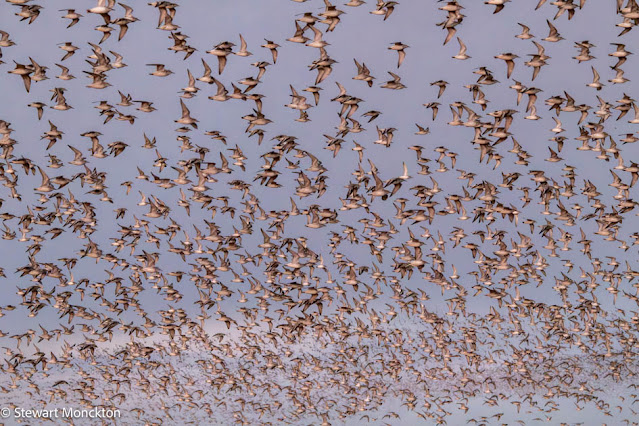An interesting point about birds and the internet: distribution map for Great Crested Grebe on Wikipedia seems to suggest that this species is non-breeding in Australia. Nobody seems to have mentioned this to the Australian birds!
Wednesday, 28 February 2024
Wild Bird Wednesday 605 - Great Crested Grebe
An interesting point about birds and the internet: distribution map for Great Crested Grebe on Wikipedia seems to suggest that this species is non-breeding in Australia. Nobody seems to have mentioned this to the Australian birds!
Wednesday, 21 February 2024
Wild Bird Wednesday 604 - Snettisham
Snettisham is a small town on the on the east coast of The Wash in the UK. There is an RSPB reserve there that gives 'views across brackish lagoons, salt marsh and a vast expanse of mudflats'. It's basically wader heaven.
I was lucky enough to be there on two days when very high tides coincided with the sunrise. This means that huge flock of Red Knot are pushed off their muddy feeding grounds by the rising tide.
This does two things - firstly it makes the Knot (and other waders) fly around in huge groups over the mud. I'm not 100% sure this is technically a murmuration as I think that term may only apply to Starlings - but I sure somebody will correct me if I'm wrong. Anyway, the visual impact in the same - huge groups of birds in the air at once: twisting and turning - and in the case of the Knot, the whole flock flashing pale white as their underwings show. And the sound they make as they fly over your head - utterly remarkable.
The second thing that happens is that once the birds have been pushed off the mud they roost in there 10's of thousands on a single bank - but those pictures are for another day,
Of course, being out at dawn presents other photographic opportunities as well.
As you will have gathered, I'm in the UK at present. If anybody wants to see other pictures from this continuing trip you can find me on FaceBook.
As ever, to join in with WBW clink on the link below. SM
You are invited to the Inlinkz link party!
Click here to enterTuesday, 13 February 2024
Wild Bird Wednesday 603 - Cuban Trogon
The Cuban Trogon (Priotelus temnurus) is endemic to Cuba, where it is also the national bird. The colours of this bird match the Cuban flag - which is probably why it's the national bird. In Spanish it is called Tocororo, which is probably onomatopoeic based on its repeated call of toco-toco-tocoro-tocoro.
As you can see in some of these pictures it has a very distinctive tail shape - and this is especially helpful in identifying the bird when it is silhouetted against bright light.
You are invited to the Inlinkz link party!
Click here to enterWednesday, 7 February 2024
Wild Bird Wednesday 602 - Cuban Tody
This delightful little bird is a Cuban Tody (Todus multicolor) - for once this is a specie where the scientific name needs to explanation!
The Todies are a family of tiny birds found only in the Caribbean. They form a distinct group with a which also includes the kingfishers, bee-eaters and rollers. I think you can see the 'kingfisher energy' in some of these pictures.
It will be no surprise to learn that the Cuban Tody is only found on Cuba - and it was an utter delight every time we saw one.
The species is small in size with a length of 11 cm and weighing 5.9 g (0.21 oz). It has a large head relative to body size, and a thin, flat bill which it use to catch insects, but will also eat fruit and small lizards.
You are invited to the Inlinkz link party!
Click here to enter


































